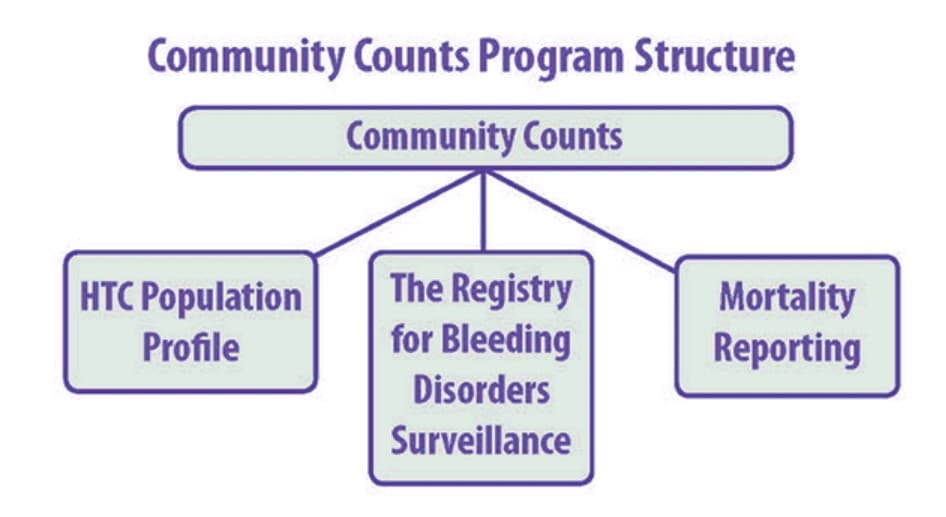Key points
- Community Counts gathers health information from people with congenital bleeding disorders who receive care at hemophilia treatment centers (HTCs) across the United States.
- The goal of Community Counts is to monitor bleeding and other complications, treatment patterns, causes of death, and other health indicators.
- The three components of Community Counts are the Registry, HTC Population Profile, and Mortality Reporting.

What it is
Community Counts is a public health monitoring program funded by CDC's Division of Blood Disorders and Public Health Genomics (DBDPHG). The purpose of this project is to gather and share information about common health issues, medical complications, and causes of death that affect people with bleeding disorders cared for in US hemophilia treatment centers (HTCs). Community Counts aims to continue the work of the Universal Data Collection System, which ended in 2011.
Community Counts is led by the DBDPHG along with its partners, the American Thrombosis and Hemostasis Network (ATHN) and the US hemophilia treatment center network (USHTCN).
Project priorities
Community Counts gathers health information
HTCs were established in 1975 to ensure access to comprehensive specialized care for people with bleeding disorders in the United States. The DBDPHG currently works with the USHTCN to collect data for public health tracking of the complications of bleeding disorders.
Eligibility
People who receive care at HTCs are eligible to participate in Community Counts if they have been diagnosed with a bleeding disorder. Their condition must be present since birth and must be one of the following bleeding disorders:
- Hemophilia A (classic hemophilia/hereditary factor VIII [8] deficiency)
- Hemophilia B (Christmas disease/hereditary factor IX [9] deficiency)
- Von Willebrand Disease
- Certain rare clotting factor disorders and platelet disorders
HTC patients with blood clots are also included in the HTC Population Profile (HTC PP) component of Community Counts.
Key health outcomes of interest
Community Counts monitors the health of people who receive care at HTCs. The program gathers and shares valuable information on the following key health outcomes:
- Bleeding events and complications: Community Counts tracks rates of complications of bleeding disorders and trends over time. These complications include joint disease, bleeding in or around the brain (also called intracranial hemorrhage), other bleeding events, and inhibitor development.
- Inhibitor development: Community Counts monitors inhibitors, which are antibodies that prevent clotting factor treatment from working. The program establishes estimates of the number of new and existing inhibitor cases in participants, identifies unexpected increases in inhibitors, and identifies risks for inhibitor development.
- Treatment practice and patterns: Early preventive treatment with clotting factor products can protect joints from damage caused by bleeds; however, there are many ways doctors prescribe these preventive treatments (also called prophylaxis). The program aims to identify how differences in preventive treatments impact health outcomes.
- Diseases that occur as a result of aging: Advances in treatments and improvements in health care have enabled people with bleeding disorders to live longer; however, medical conditions that come with older ages are now of concern. Community Counts aims to document the impact of these conditions on participants.
- Causes of death: Community Counts tracks the causes of death among people with bleeding disorders. This information is used to describe trends in the causes of death and to identify potentially preventable causes of death that occur more often among people with bleeding disorders.
- Use of health services: Community Counts monitors the health and economic impact of bleeding disorders by collecting information on the frequency and location of HTC care, emergency room visits and participant hospitalizations. This information can be used to make important policy decisions and continuously improve access to specialized care.
Program structure

This chart shows the Community Counts program structure. It indicates that Community Counts is the larger program, and that the HTC PP, the Registry for Bleeding Disorders Surveillance, and Mortality Reporting are all distinct but equally important components under the Community Counts program.
Components of Community Counts
HTC Population Profile
The HTC PP gathers basic information on all HTC patients with bleeding disorders or blood clots. The following patient demographic information is gathered by the HTC PP:
- Age
- Sex
- Race/ethnicity
- Year of birth
- 3-digit ZIP code (first 3 digits of ZIP code of residence)
- Insurance status
- Year of visit to HTC
- Primary bleeding or clotting disorder
- Baseline factor level/von Willebrand disease laboratory values
- VTE occurrence
- HCV status
- HIV status
This information is used to determine the size and characteristics of the patient population receiving care in the HTCs.
Registry for Bleeding Disorders Surveillance
The Registry for Bleeding Disorders Surveillance (the Registry) gathers more detailed information on HTC patients with bleeding disorders. People who volunteer to participate will have routine medical information collected during HTC visits. Only HTC patients with bleeding disorders can participate in the Registry.
The Registry monitors the following items:
- Characteristics that increase the risk for complications from bleeding disorders
- The outcomes of bleeding disorders
- The impact of bleeding disorders on participants
The Registry contains the following participant information:
- Patient characteristics
- Patient diagnoses
- Bleeding events (including bleeding into joints and/or brain)
- History of inhibitors
- Treatments (including preventive measures)
- Treatment product use
- Presence of other medical conditions
Blood samples are collected from participants. CDC provides free inhibitor testing for participants who have hemophilia or type 3 von Willebrand disease who use certain treatment products.
The information in the Registry will be used to increase knowledge about the following:
- Medical complications among people with bleeding disorders
- Individuals most suited for prevention programs
- Areas where more study is needed
Mortality Reporting
This project tracks the characteristics, diagnoses, and causes of death of HTC patients with bleeding disorders who have died. This information will be used to monitor trends in the causes of death and to identify causes of death that occur more often among people with bleeding disorders.
